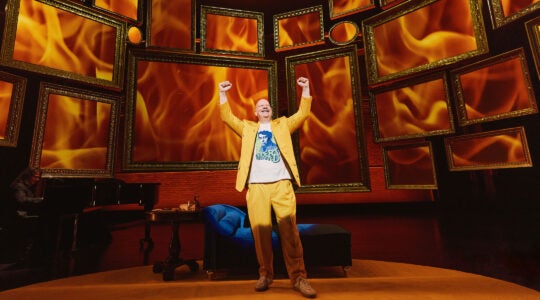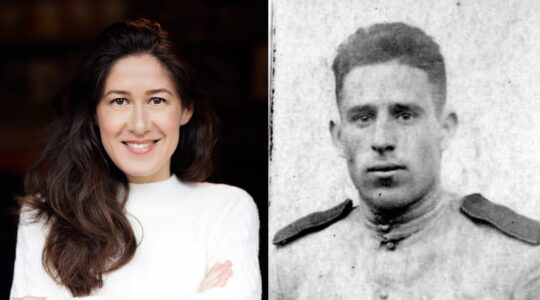I had the privilege of spending much of the summer in Israel, meeting with artists and curators and generally re-acquainting myself with the art scene there. While the reopening of the magnificent Israel Museum in Jerusalem was the most noteworthy event of my trip, meetings at galleries, museums and performances crystallized the idea that art offers a window into the soul — and the possibilities — of Israeli life today.
Among the most obvious findings: The quality of art in Israel is incredibly high, especially — but not exclusively — in Tel Aviv. Whether it was the sagging, concrete Torahs of Erez Israeli, the political video theories of Adam Berg or the Russian-inflected Haggadah of Zoya Cherkassky, new work by emerging artists was in deep conversation both with Jewish tradition and contemporary trends in art.
Roberta Smith’s recent review in The New York Times of two shows — “Greater New York” at MoMA P.S. 1 Contemporary Art Center and “The Young Israelis” at the Lesley Heller Workspace — could stand in for a review of contemporary art in general: “Small though it is, Israel has been providing more than its share of artistic talent to the global art circuit, especially where video and performance art are concerned.”
Indeed, the quality of video art seemed exceptionally exciting. Video seems to fall into two categories. On the one hand is the gorgeous and hypnotic work of Michal Rovner, Yael Bartana and Nira Pereg — Rovner’s being the more philosophical, Bartana’s the more political, and Pereg’s the more sociological. It says something about Rovner and the power of video in Israeli society that the first installation at Yad Vashem’s recently constructed Holocaust History Museum is a cinematic pastiche by Rovner.
On the other side is the more satirical work of multi-disciplinary artists like Roee Rosen and Eli Petel. Rosen’s new film, “Out,” now at the Venice Film Festival, asserts that a young woman is plagued by the spirit of Foreign Minister Avigdor Lieberman, and that only a session of sado-masochism can release this dybbuk. As provocative as this sounds, this film is as interesting a reflection on how deeply embedded politics is in Israel’s life as anything I have seen or read.
Eli Petel’s work “Reverse” presents a short video of him driving to synagogue, but backwards — and filming himself doing it. This exercise, among other things, drives home the difficulty so many Israelis have of finding their way to religious observance, the camera of their own judgment a character in the drama of the secular/religious split in Israel.
Video also seems particularly well suited to the frantic pace of life in Israel, as well as the way in which Israeli life is broadcast, dissected and often delegitimized around the world. Oddly, it was the same day I saw much of the above work that I first watched the online video spoof “We Con The World,” about the world’s outsized response to the Gaza flotilla. Israeli artists have responded to the flattening of Israeli life represented by the international video media, and using humor and sophistication to tell their story.
Although much of Israeli art concerns daily life unconnected to Jewish ideas, there does seem to be a return to Jewish content. This trend might be best expressed in one of the many new developments at Beit Hatfutsot, which has changed its English name from Museum of the Jewish Diaspora to Museum of the Jewish People (more on that in a minute).
Among the changes there are a reworking of the core exhibition, focused more on the sweep of Jewish religious civilization, and less on the classic Zionist paradigm of Jewish life being one long journey back to Israel. Another is the series of temporary exhibitions exploring aspects of contemporary Israeli/Jewish life, including the recent shows “With this Ring: Wedding Ceremonies in Contemporary Art” and “Judaica Twist: Innovation in Judaica Design.”
Another fascinating trend is the dynamic of artists working together, from the development of group shows like the current photography exhibition “Living Room” at the Tel Aviv Museum of Art, which features the work of young graduates of the pre-eminent Bezalel Academy of Art and Design, to the decades-old collaboration of middle-aged designers and architects of The Tav Group, whose work infiltrates museums, art fairs and logotype across the country.
Some of this reflects the reality of a difficult economic profession in a small art market. More symbolically, this trend reflects the continuing importance of community in Israel, and the need for world Jewry to believe that “Jewish community” is not a contradiction in terms. At a time when Jews inside and outside of Israel need to understand their common ground, the idea that there may truly be a Museum of the Jewish People — even that there is a “Jewish People” — is a masterpiece waiting for its canvas. n
Daniel Schifrin is director of public programs and writer in residence at the Contemporary Jewish Museum in San Francisco.
The New York Jewish Week brings you the stories behind the headlines, keeping you connected to Jewish life in New York. Help sustain the reporting you trust by donating today.




